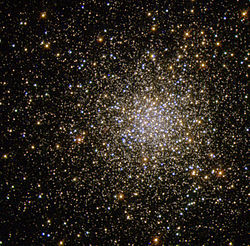| NGC 5694 | |
|---|---|
 The core of NGC 5694 imaged by the Hubble Space Telescope | |
| Observation data (J2000 epoch) | |
| Class | VII [1] |
| Constellation | Hydra |
| Right ascension | 14h 39m 36.5s [2] |
| Declination | −26° 32′ 18.0″ [2] |
| Distance | 114,100ly [1] |
| Apparent magnitude (V) | 10.2 [1] |
| Apparent dimensions (V) | 3.6′ [1] |
| Physical characteristics | |
| Metallicity | = –1.74 [3] dex |
| Estimated age | 13.44 Gyr [3] |
| Other designations | Caldwell 66 |
NGC 5694 (also known as Caldwell 66) is a globular cluster in the constellation Hydra. It was discovered in 1784 by William Herschel.
